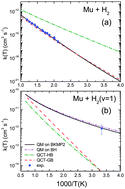Quantum mechanical (QM) and quasiclassical trajectory (QCT) calculations have been carried out for the exchange reactions of D and Mu (Mu = muonium) with hydrogen molecules in their ground and first vibrational states. In all the cases considered, the QM rate coefficients, k(T), are in very good agreement with the available experimental results. In particular, QM calculations on the most accurate potential energy surfaces (PESs) predict a rate coefficient for the Mu + H2 (ν = 1) reaction which is very close to the preliminary estimate of its experimental value at 300 K. In contrast to the D + H2 (ν = 0,1) and the Mu + H2 (ν = 0) reactions, the QCT calculations for Mu + H2 (ν = 1) predict a much smaller k(T) than that obtained with the accurate QM method. This behaviour is indicative of tunneling. The QM reaction probabilities and total reactive cross sections show that the total energy thresholds for the reactions of Mu with H2 in ν = 0 and ν = 1 are very similar, whereas for the corresponding reaction with D the ν = 0 total energy threshold is about 0.3 eV lower than that for ν = 1. The results just mentioned can be explained by considering the vibrational adiabatic potentials along the minimum energy path. The threshold for the reaction of Mu with H2 in both ν = 0 and ν = 1 states is the same and is given by the height of the ground vibrational adiabatic collinear potential, whereas for the D + H2 reaction the adiabaticity is preserved and the threshold for the reaction in ν = 1 is very close to the height of the ν = 1 adiabatic collinear barrier. For Mu + H2 (ν = 1) the reaction takes place by crossing from the ν = 1 to the ν = 0 adiabat, since the exit channel leading to MuH (ν = 1) is not energetically accessible. At the lowest possible energies, the non-adiabatic vibrational crossing implies a strong tunneling effect through the ν = 1 adiabatic barrier. Absence of tunneling in the classical calculations results in a threshold that coincides with the height of the ν = 1 adiabatic barrier. Most interestingly, the expected tunneling effect in the reaction of Mu with hydrogen molecules occurs for H2 (ν = 1) but not for H2 (ν = 0) where zero-point-energy effects clearly dominate.

You have access to this article
 Please wait while we load your content...
Something went wrong. Try again?
Please wait while we load your content...
Something went wrong. Try again?


 Please wait while we load your content...
Please wait while we load your content...